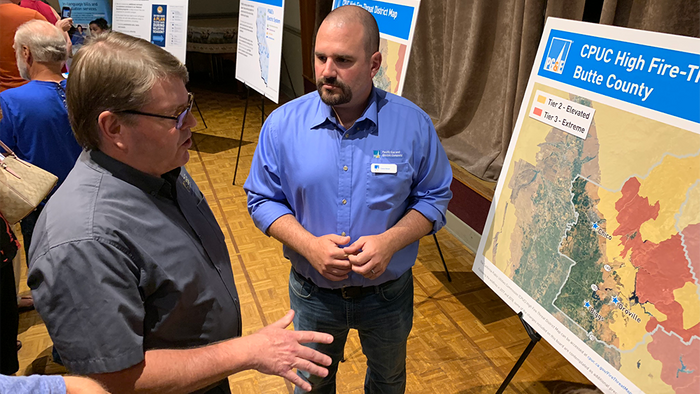How Will PG&E’s Wildfire Prevention Shut-Downs Affect the North Valley?
Alternative Energy Systems
-

Dave Meier of PG&E talks with Jim Mikles from AES
-

Jim Mikles from AES reviews the CPUC FireMap with Dave Meier of PG&E
Many people in the North Valley have been trying to learn more about what to expect from the emergency power outages PG&E has planned for the region when weather conditions make wildfires likely to happen. On June 12, 2019, PG&E held an open house at the Chico Elks Lodge to circulate information to the public, and offer an opportunity for people to ask questions of the representatives in attendance.
Alternative Energy System’s Director of Sales, Jim Mikles, attended the open house to ask questions and find out how these preparations will affect our customers, and spoke to PG&E’s Dave Meier.
According to Meier, those in the valley floor area are the least likely to be affected by any of the power outage events, but this may change depending on what kind of weather event the region experiences. Low humidity and dry winds leave the North Valley in an elevated risk of wildfire, so coupling these conditions would put the region on alert.
Mikles asked how valley areas served by substations fed by transmission lines running through the elevated and extreme risk areas would be affected, and Meier indicated there is potential for shutdown in those areas as a result.
Click to see the CPUC FIreMap and find out if you'll be affected by the outages
When asked if PG&E was suggesting customers in potentially affected areas need backup generator or battery storage, Meier continued that it depended on each individual customer’s needs. Since the outages will affect even those on medical baseline plans, it would be worth it for those dependent on a steady supply of energy to ensure they had a backup plan.
For shorter-term energy concerns, purchasing a gas-powered portable generator might be sufficient to meet your needs. From the Emergency Power Planning literature handed out at the event, a gas-powered portable generator providing 2,000 to 2,500 watts would be sufficient to power a refrigerator and several lights. When the doors are kept shut, refrigerators only need to be powered 15 minutes every hour to keep food cool, so if needed, they could be unplugged periodically so other devices could be operated or charged.
For longer-term energy backup and storage considerations, North Valley customers with existing solar systems can consider adding Tesla Powerwall storage to their systems. Adding properly-sized battery storage to a solar system offers energy backup when the power is out, as well as allowing the solar customer to keep their system on while others with solar-only are deactivated during power outages.
Due to high-demand, AES is only offering Tesla Powerwalls to current solar customers at this time. For more information such as pricing and system requirements, contact us here.
